- 1 TL;DR (Quick Answer)
- 2 Why Linux Creators Want CapCut
- 3 Prerequisites & System Requirements (Recommended)
- 4 Method 1 — Install & Run CapCut with Wine (Most Control)
- 5 Method 2 — Use Bottles (GUI Wrapper for Wine)
- 6 Method 3 — Virtual Machine (Maximum Compatibility)
- 7 Performance Tuning (All Methods)
- 8 What Works Well vs. What Needs Internet
- 9 Troubleshooting (Fast Fix Table)
- 10 FAQs
- 11 Suggested Internal Links (Strengthen Your Topic Cluster)
- 12 Conclusion: Should You Use CapCut on Linux?
f you’re a creator who loves Linux, you’ve probably noticed that many popular editors don’t offer native builds. The good news: you can still enjoy a full-featured workflow with CapCut Pro for Linux. In this practical, SEO-optimized guide, you’ll learn exactly how to set up, launch, and optimize CapCut on leading distros using Wine, Bottles, or a virtual machine—without leaving your favorite OS. By the end, you’ll be able to edit, export, and ship videos confidently, even on modest hardware.

TL;DR (Quick Answer)
- There’s no native package yet, but CapCut Pro for Linux runs reliably with Wine/Bottles.
- For the fastest setup, Bottles provides a clean, GUI-based Wine environment.
- For maximum compatibility, a Windows VM (VirtualBox/VMware) is the most predictable path.
- Prepare your system (GPU drivers, codecs, storage), then install capcut on linux in a dedicated Wine prefix and run capcut using wine with hardware acceleration enabled.
- Tested logic works well on Ubuntu, Debian, Fedora, Arch—great news for capcut ubuntu users and those running capcut on linux mint.
Target users who search for capcut linux, install capcut on linux, and capcut app for linux will find a step-by-step path here that balances ease, stability, and performance.
Why Linux Creators Want CapCut
CapCut’s appeal is simple: a modern, easy interface with robust features (multitrack timeline, motion tracking, chroma key, auto captions, LUT/color tools, rich templates) and smooth 4K export. Running CapCut Pro for Linux lets you keep your open-source workflow while leveraging CapCut’s cloud ecosystem across devices.
- Cross-platform continuity: start on mobile, finish on desktop.
- Creator-friendly presets for YouTube, TikTok, Instagram.
- A fast learning curve for newcomers without sacrificing power.
You’ll see repeated references to capcut linux throughout this tutorial because that’s how most users search for it—keep that in mind when naming your project folders and documenting your setup.
Prerequisites & System Requirements (Recommended)
| Component | Recommendation |
|---|---|
| Distro | Ubuntu 22.04+, Linux Mint 21+, Fedora 39+, Arch (latest) |
| CPU | Modern 64-bit processor |
| RAM | 8 GB minimum (16 GB recommended) |
| GPU | Intel/AMD open drivers or Nvidia proprietary with latest stable version |
| Storage | 10–20 GB free for cache and exports |
| Extras | Wine 8.x+ or Bottles (latest), VirtualBox/VMware if going VM route |
Pro tip: If your goal is ultimate stability, a VM is the safest path. If you prefer the lightest footprint and tighter OS integration, run capcut using wine (or Bottles).
Method 1 — Install & Run CapCut with Wine (Most Control)
This path suits users who like terminal control and lean setups. We’ll create a clean 64-bit Wine prefix, install essential components, then install capcut on linux inside that environment.
You can learn more about Wine compatibility on the official WineHQ documentation.
1) Install Wine and helpers
Ubuntu / Linux Mint (great for capcut ubuntu and capcut on linux mint users):
sudo dpkg --add-architecture i386
sudo apt update
sudo apt install -y wine64 wine32 winetricks cabextractsudo dnf install -y wine winetricks cabextract2) Create a dedicated Wine prefix
export WINEARCH=win64
export WINEPREFIX=$HOME/.wine-capcut
winecfg- In winecfg, set Windows version to Windows 10.
3) Install core runtime components with Winetricks
winetricks -q vcrun2019 corefontsDepending on your setup, you may add d3dcompiler or dxvk for improved rendering.
4) Download the official Windows installer
Grab the official CapCut Windows installer (CapCut_Installer.exe). Save it to ~/Downloads.
5) Install CapCut in the prefix
cd ~/Downloads
WINEPREFIX=$HOME/.wine-capcut wine CapCut_Installer.exeFollow the installer prompts. After completion, you’ll find a CapCut entry in your Wine app menu or you can launch it directly:
WINEPREFIX=$HOME/.wine-capcut wine "$HOME/.wine-capcut/drive_c/Program Files/CapCut/CapCut.exe"If your package manager offers dxvk (Vulkan translation layer), enable it to boost GPU-accelerated playback and exports.
With these steps, you’ve installed capcut on linux using Wine—one of the cleanest approaches for capcut app for linux power users.
Method 2 — Use Bottles (GUI Wrapper for Wine)
Bottles simplifies Wine management with presets and isolated environments (“bottles”). It’s user-friendly and reduces conflicts.
- Install Bottles (Flatpak is common):
flatpak install flathub com.usebottles.bottles- Create a new bottle (e.g., “CapCut”), choose a Gaming or Application preset.
- Install dependencies in the bottle (e.g., vcrun2019).
- Run the CapCut installer inside Bottles (Add → Run Executable → select
CapCut_Installer.exe). - Pin your bottle and set CapCut as a runnable app.
Bottles reduces tinkering and is a great recommendation for readers searching capcut linux who prefer a point-and-click path to run capcut using wine.
For further guidance, check the official Bottles documentation.
Method 3 — Virtual Machine (Maximum Compatibility)
If you hit blockers with Wine/Bottles or need predictable stability for client work:
- Install VirtualBox (or VMware Workstation Player).
- Create a Windows 10/11 VM with 4–8 GB RAM and 2–4 cores.
- Enable 3D acceleration in VM settings.
- Install CapCut normally within Windows.
- Share a host folder for easy import/export of media.
This approach is nearly foolproof and ideal for mission-critical edits, though hardware acceleration may be less efficient than native.
Performance Tuning (All Methods)
- Drivers: Keep GPU drivers current (Nvidia proprietary or up-to-date Mesa).
- Hardware acceleration: Enable DXVK/Vulkan where available.
- Cache location: Use SSD/NVMe for CapCut cache and export directories.
- Preview resolution: Lower preview quality during heavy edits; export at full quality.
- Background apps: Close browsers and heavy processes during export.
- Project hygiene: Keep short clip proxies and purge unused assets before the final render.
These tweaks will help no matter whether you’re on capcut ubuntu, capcut on linux mint, Fedora, or Arch, and they’ll make your capcut app for linux workflow much smoother.
What Works Well vs. What Needs Internet
Works offline (great for travelers and remote shoots):
- Timeline editing, cuts, trims, transitions
- Color tools, LUTs (once downloaded)
- Titles, captions (manual), overlays
- 1080p/4K exports to local storage
Requires internet:
- Downloading new templates/effects
- Auto-captions, some AI features
- Cloud sync across devices
- Direct uploads to platforms
This aligns perfectly with our CapCut Pro Offline guide, and many readers who discover CapCut Pro for Linux also want a reliable offline workflow.
Troubleshooting (Fast Fix Table)
| Issue | Likely Cause | Fix |
|---|---|---|
| App won’t start | Missing runtime/DXVK | Install vcrun2019 via winetricks, enable DXVK |
| Black/blank preview | GPU driver/D3D issue | Update drivers; toggle DXVK/VKD3D |
| Stutters on playback | Cache/preview too heavy | Lower preview quality; set cache on SSD |
| Export freezing | Low RAM/disk | Close apps; increase swap; free disk |
| Login loop | Cookies/session in Wine | Clear Wine prefix appdata; re-sign in |
| Installer fails | Corrupt EXE | Re-download official installer |
These fixes cover 80% of roadblocks you’ll encounter when you run capcut using wine or Bottles.
FAQs
Is there a native Linux version?
Not yet. But CapCut Pro for Linux via Wine/Bottles is a solid workaround for most use cases.
Is performance good enough for client work?
Yes, especially on modern CPUs/GPUs with DXVK. For guaranteed stability, a Windows VM is a safe plan B.
Which distro is best?
Ubuntu/Mint (huge community help), Fedora (newer stacks), and Arch (bleeding-edge). This guide explicitly supports capcut ubuntu and capcut on linux mint among others.
Can I sync projects with my phone?
Yes, once online. Offline work is fully possible; cloud sync resumes when you reconnect.
Suggested Internal Links (Strengthen Your Topic Cluster)
- CapCut Pro on Mac — Full Setup & Compatibility Guide (2025)
Ideal for readers who alternate between Linux and macOS and want the smoothest Mac workflow. - How to Use CapCut Pro Offline — Full Editing Guide 2025
Perfect companion for travelers and those editing in low-connectivity environments. - Download CapCut Pro for PC — Full Windows Guide
For dual-boot users who keep a Windows partition for maximum compatibility. - CapCut Pro Pricing Guide (2025)
Helps readers choose the best plan once their Linux setup is stable.
Interlinking these pieces ensures that visitors who arrive via capcut linux queries can also discover your Mac/PC/Offline resources, boosting session duration, topical authority, and conversions.
Conclusion: Should You Use CapCut on Linux?
Absolutely. While a native build would be ideal, CapCut Pro for Linux is more than viable today. For tinkerers, Wine or Bottles offers a quick, lightweight solution. For editors who need guaranteed predictability, a Windows VM delivers dependable results. Either way, you keep your Linux workflow, your favorite tools, and your creative freedom.
If your goal is to install capcut on linux once and get editing, follow the Wine or Bottles path above. If you need the “just-works” approach, spin up a VM. Whichever route you choose, you’ll still enjoy CapCut’s professional toolset, exports up to 4K, and a streamlined interface that makes video creation fast and fun.


